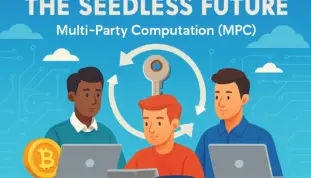Seedless Web3 Security: MPC, AA, and the End of the Seed Phrase Threat
The Seedless Future: MPC, Account Abstraction, and the Revolution of Web3 UX Security
Seed phrases are the single greatest barrier to Web3 mass adoption. They create anxiety, friction, and a constant threat of irreversible loss. As the industry matures, the shift toward seedless recovery is not just a UX upgrade—it’s a foundational security revolution.

This article explores the convergence of three pillars: Account Abstraction (AA), MPC Wallets (MPC), and Wallet UX Security. Together, they form the architecture of a non-custodial, programmable, and resilient future for Web3 wallets.
Thesis: By 2026, the dominant wallet infrastructure will be modular, seedless, and powered by smart contract logic and cryptographic custody. Let’s begin with the customization layer—Account Abstraction.
Account Abstraction (AA) — The Customization Layer
ERC-4337 and the Smart Contract Wallet Revolution
Account Abstraction (AA) enables wallets to behave like programmable smart contracts. The technical standard driving this shift is ERC-4337, which introduces a new transaction flow built around three components:

- UserOperation: A structured transaction request submitted by the user.
- Bundler: A relayer that aggregates UserOperations and submits them to the blockchain.
- Entrypoint: A smart contract that validates and executes the operations.
This architecture removes the dependency on externally owned accounts (EOAs) and opens the door to programmable wallet logic, including custom authentication, spending limits, and recovery flows.
Eliminating UX Friction with the Paymaster
One of the most powerful features of AA is the paymaster—a module that abstracts gas fees. Instead of requiring users to hold native tokens (e.g., ETH), the paymaster allows fees to be paid in ERC-20 tokens or even subsidized entirely.
This dramatically reduces UX friction during onboarding and transaction signing, making Web3 wallets more accessible to mainstream users. It also enables new monetization models and onboarding flows for dApps and custodians.
Architecture Comparison
| Feature | EOA (Traditional) | Smart Contract Wallet (AA) | AA + MPC Hybrid |
|---|---|---|---|
| Key Type | Single Private Key | AA (Logic-Based) | Threshold Signatures |
| Recovery | Seed Phrase only | Social Recovery Guardians | Share-Based Keys |
| Fee Payment | L1 Native Token only | Paymaster enabled | Paymaster enabled |
| Single Point of Failure | High (Seed Phrase) | Medium (Guardian Risk) | Low (Requires M of N shares) |
| Security Mechanism | Cryptography | Logic/Code | Multi-Party Computation |
MPC — Cryptography Meets Custody
The Mechanics of Threshold Signatures and Key Sharding
Multi-party computation (MPC) is a cryptographic process where a private key is never created or stored in full. Instead, it is split into key shares across multiple devices or servers. These shares collaboratively generate a threshold signature without ever reconstructing the full key.

The core security property is the M of N threshold: only M shares (out of N total) are required to authorize a transaction. This ensures that even if some shares are compromised, the system remains secure.
Unlike traditional multi-sig setups—where multiple wallets sign a transaction after the full key is used—MPC ensures the key itself never exists in one place. This distinction is critical for institutional-grade custody and resilience.
Two major cryptographic schemes power MPC wallets:
- Threshold ECDSA: Compatible with existing blockchain infrastructure.
- Threshold Schnorr: Offers improved efficiency and aggregation properties.
These schemes enable non-custodial by design wallets, where the user retains control without relying on a single device or seed phrase. For secure share creation and exchange, protocols often use zero-knowledge proof of knowledge to validate integrity without revealing secrets.
Institutional Adoption and Provider Landscape
Enterprise-grade MPC solutions are already being deployed by leading providers such as Fireblocks, Zengo, and others. These platforms offer programmable custody, compliance integrations, and scalable key management for both retail and institutional users.

Key management in MPC wallets requires rigorous operational discipline. The process typically includes:
- Key ceremony: Initial generation and distribution of key shares across trusted devices or parties.
- Key rotation / share rotation: Periodic refreshing of shares to mitigate long-term exposure and insider risk.
Compared to traditional custody models, cryptographic custody via MPC offers superior resilience, auditability, and decentralization. It eliminates the need for centralized vaults or custodians, while maintaining institutional-grade security.
The New Security UX
Seedless Recovery and the Power of Social Recovery Guardians
The anxiety of losing a seed phrase is one of the most persistent pain points in Web3. Account Abstraction (AA) introduces a powerful alternative: social recovery guardians.
These guardians can be trusted friends, hardware devices, or third-party services that help recover access without relying on a single secret. Instead of storing a fragile phrase, users configure recovery logic into their smart contract wallet.
This approach transforms recovery from a static backup into a dynamic, programmable process. Compared to traditional seed phrase recovery, guardian-based recovery offers greater flexibility and human-centric design—but introduces new risks around trust and coordination.
Biometrics, Hardware, and Cloud Integration
Modern wallets increasingly combine biometric + mpc authentication to streamline access. Fingerprint or facial recognition can trigger MPC signing across devices, creating a seamless experience without compromising security.
However, integrating cloud-based key shares introduces a new threat vector: cloud key share risk. If a cloud provider is compromised, key shares may be exposed. To mitigate this, many wallets adopt a cold storage + mpc hybrid model—storing some shares offline while others remain accessible for daily use.
This layered approach balances convenience with resilience, ensuring that users can recover access even in hostile or disconnected environments.
Recovery Mechanisms Comparison
| Mechanism | Method | Pros | Cons/Risk |
|---|---|---|---|
| Seed Phrase | Physical storage, memorization | Full financial sovereignty | UX friction, single point of failure |
| Social Recovery | Trusted friends/devices | Convenient, no seed phrase needed | Reliance on human Guardians |
| MPC Share Recovery | Recombine key shares | High cryptographic security | Managing cloud key share risk |
Advanced Auditing and Regulatory Landscape
The Future of Transparency: zk-proofs для аудита транзакций
As programmable wallets evolve, so does the need for verifiable privacy. zk-proofs для аудита транзакций offer a way to prove transaction integrity without revealing sensitive details. When layered onto Account Abstraction, they enable selective disclosure, institutional auditability, and privacy-preserving compliance.
Regulatory Custody Questions for 2026
The rise of non-custodial seedless recovery challenges traditional definitions of custody and money transmission. Under current interpretations by FinCEN and the IRS, custody often hinges on control of private keys. But in AA/MPC wallets, control is programmatic and distributed.
Does a Bundler or a Social Recovery Guardian qualify as a custodian? Can a developer of AA logic be considered a money transmitter? These are open questions that regulators must address as programmable wallets become mainstream.
Meanwhile, compliance solutions are emerging:
- OFAC screening layers can be embedded into AA logic, ensuring that transactions are pre-validated against sanction lists.
- AML/KYC enforcement can be modularized via smart contract conditions, turning compliance from a burden into a feature.
- Paymaster logic complicates tax reporting, as the originator of a transaction may not be the fee payer—raising questions about cost basis and attribution.
These challenges are not roadblocks—they are opportunities to redefine compliance in a modular, programmable way.
Maintaining Resilience: Key Rotation / Share Rotation
Long-term security in MPC wallets depends on periodic key rotation / share rotation. Over time, static key shares become vulnerable to insider threats, cloud compromise, or device loss. Rotating shares ensures that no single point of exposure persists indefinitely.
Best practices include automated rotation schedules, multi-device confirmations, and audit trails for institutional oversight. This is essential for maintaining cryptographic integrity in high-value environments.
2026 Forecast — The Dominance of the Modular Wallet
The convergence of MPC and Account Abstraction is not theoretical—it’s already reshaping wallet architecture. By 2026, most major L2 chains will support native AA, and MPC-enabled smart contract wallets will become the industry standard.
This modular stack offers programmable UX, cryptographic custody, and scalable compliance. But the final layer—the human-centric security experience—remains the most important. Developers must focus on eliminating friction, reducing anxiety, and empowering users with intuitive recovery and authentication flows.
FAQ
What is the difference between MPC and AA?
MPC is a cryptographic method for securing keys via distributed computation. AA is a smart contract framework that enables programmable wallet logic. Together, they form a seedless, non-custodial wallet architecture.
Can MPC wallets still lose funds?
Yes. If the required threshold of key shares (M of N) is compromised or lost, access to funds may be permanently lost. Redundancy and rotation are critical.
What is the role of a Bundler in ERC-4337?
The Bundler aggregates UserOperation requests and submits them to the blockchain via the Entrypoint contract. It acts as a relayer and validator in the AA flow.
Is Social Recovery truly non-custodial?
Yes, if implemented correctly. Guardians do not hold keys—they authorize recovery via smart contract logic. However, trust and coordination risks remain.
Disclaimer
This article discusses experimental technologies and evolving regulatory interpretations. Web3 custody models, including MPC and Account Abstraction, are not yet fully standardized or legally defined. Readers should consult qualified professionals before making financial or architectural decisions. The authors do not provide legal or investment advice.
